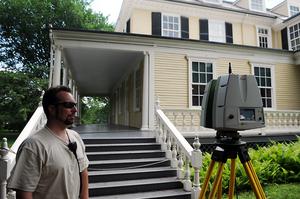While laser scanning for historic preservation is no longer “new,” it’s interesting to see the new ways in which using laser scanning and other 3D data capture techniques are being mainstreamed into very traditional fields. Like archaeology. I don’t think fields get any more traditional than that.
I recently came upon an article in a local Cambridge, Mass., paper that detailed work being done on the Longfellow-Washington Headquarter House that started this way: “The Longfellow-Washington Headquarter House is undergoing a high-tech archaeological ‘dig’ this summer through a grant from the National Park Service.” So often, I find myself trying to explain what 3D laser scanning actually is. This is something people can understand: It’s a tool that helps archaeologists uncover and document the past (among other things). It’s the new archaeology!
Plus I just love the juxtaposition of a laser scanning technician standing there in front of an old Victorian home in tony the tony Boston suburb of Cambridge. It looks like a scene out of a sci-fi movie:
And how’s this for a quote to help promote the laser scanning and 3D data capture industry: “It’s an entirely new age for doing survey work,” said Steven Pendery, New England regional archaeologist for the National Park System. “Traditional excavation is destructive and expensive, and often not justified. New technology allows us to explore historic sites economically and nondestructively.”They’re even integrating ground-penetrating radar to see what they can find underground, in a pretty nice combination of 3D technologies.
But say you’re a budding archaeologist and starting to get excited about the technology? Think this part might turn you off a little bit: “The equipment itself is expensive. One laser scanner costs about $120,000 …”
Ack. That doesn’t exactly make the technology seem accessible, does it? As long as laser scanning is seen as a technology only for the most well-funded operations, it’s hard to see it weaving its way into mainstream archaeology. Luckily, prices are coming down – but is that message actually getting out to the market?






